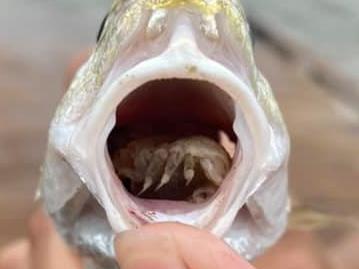Section Branding
Header Content
The tongue-eating louse does exactly what its name suggests
Primary Content
It's the stuff of nightmares, or science fiction: a parasite that wants to get inside an animal's mouth, where it attacks — and replaces — the tongue. That's the incredibly specific, terribly icky job of the tongue-eating louse.
Luckily for humans, the isopod doesn't affect people. But the Atlantic croaker and other fish are less fortunate, as a recent Facebook posting by the Galveston Island State Park in Texas shows.
"This parasite detaches the fish's tongue, attaches itself to the fish's mouth, and becomes its tongue," the wildlife agency said, expounding on a photo showing the isopod curled inside a croaker's mouth. "The parasite then feeds on the fish's mucus. It also happens to be the only known case where a parasite functionally replaces a host's organ."
Several commenters on the post said that for years now, they've seen the tongue-eating louse on fish in nearby Gulf of Mexico waters.
Along with croaker, the parasite is commonly found in the mouths of sea trout and several snapper species, Mark Fisher, science director for the Texas Parks and Wildlife Department's coastal fisheries division, told Texas TV station KSAT.
"These are isopod crustaceans and are related to the pill bugs, a.k.a. rolly-pollies, you can find in your yard," Fisher added.
It seems that several parasites in the louse's Cymothoa genus use a similar tactic.
Menhaden fish are so often seen with their tongue replaced by the isopod that they're known as "bug mouths," according to the website North Carolina Fishes. And they're so common in snapper that that version of the louse has a second name: snapper-choking isopod.
Copyright 2021 NPR. To see more, visit https://www.npr.org.

